Lecture 14: Humanistic Psychotherapy
1/79
Earn XP
Description and Tags
By Jordana Burstein for Clinical Psychology
Name | Mastery | Learn | Test | Matching | Spaced |
|---|
No study sessions yet.
80 Terms
Who are the two major figures of humanistic psychotherapy? (Humanistic Psychotherapy)
The two major figures of humanistic psychotherapy are Carl Rogers and Abraham Maslow.
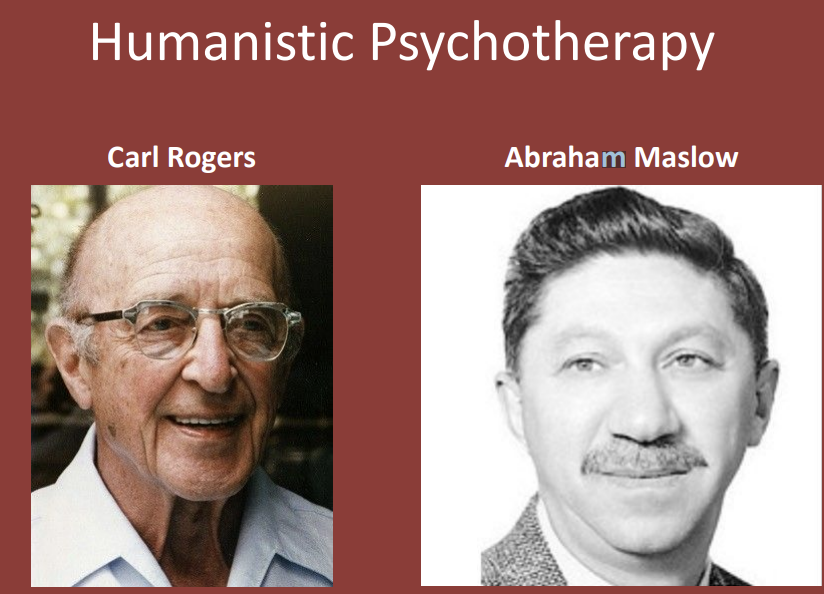
What did humanistic psychotherapy stand in opposition to? (Humanistic Psychotherapy)
Humanistic psychotherapy stood in opposition to the psychodynamic approach, particularly the biologically-based, id-dominated, and cynical Freudian view.
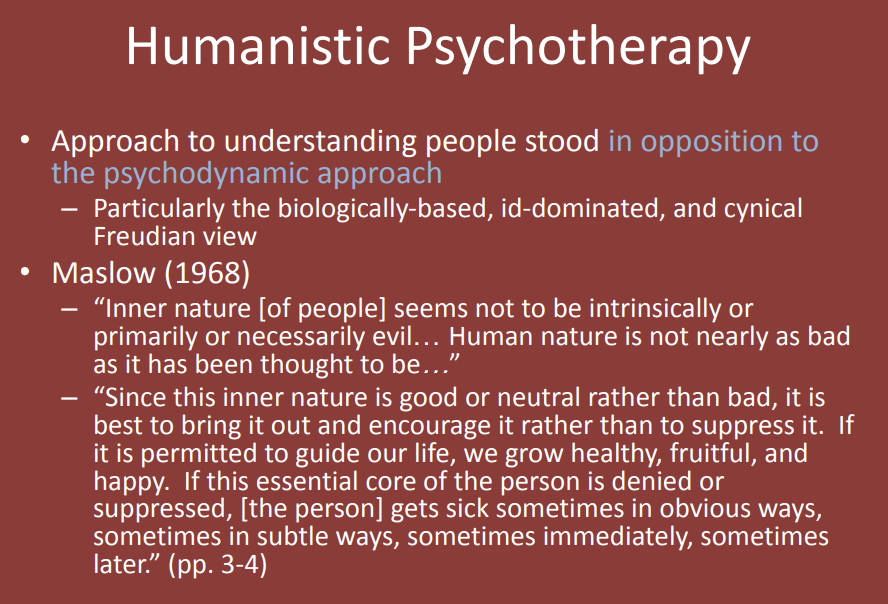
What did Abraham Maslow say about human nature? (Humanistic Psychotherapy)
Maslow said that human nature is not inherently evil, and that inner nature is good or neutral rather than bad. He believed that allowing this inner nature to guide one's life leads to healthy, fruitful, and happy growth.
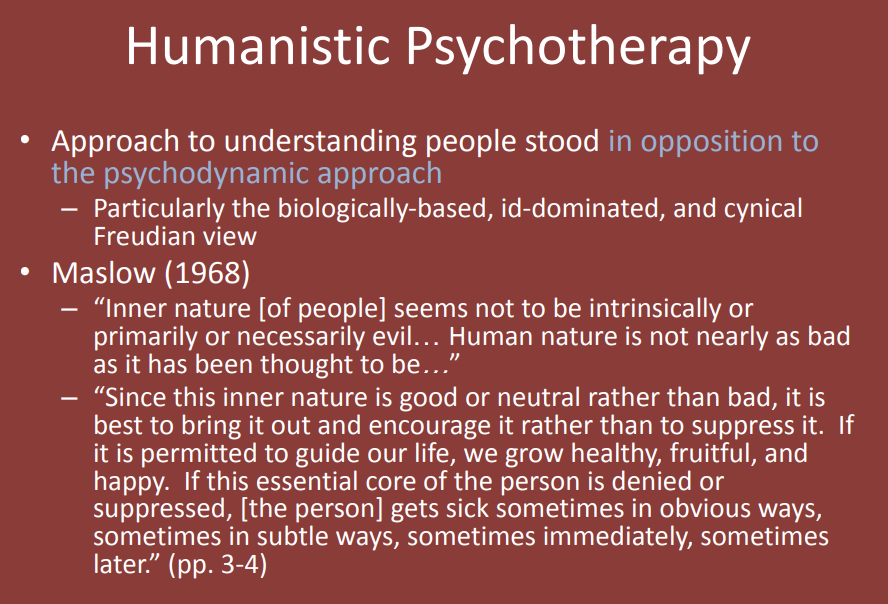
How did Carl Rogers apply Maslow's theory? (Humanistic Psychotherapy)
Carl Rogers applied Maslow's theory to people with psychological problems, helping to develop an approach that remains highly influential in psychotherapy today.
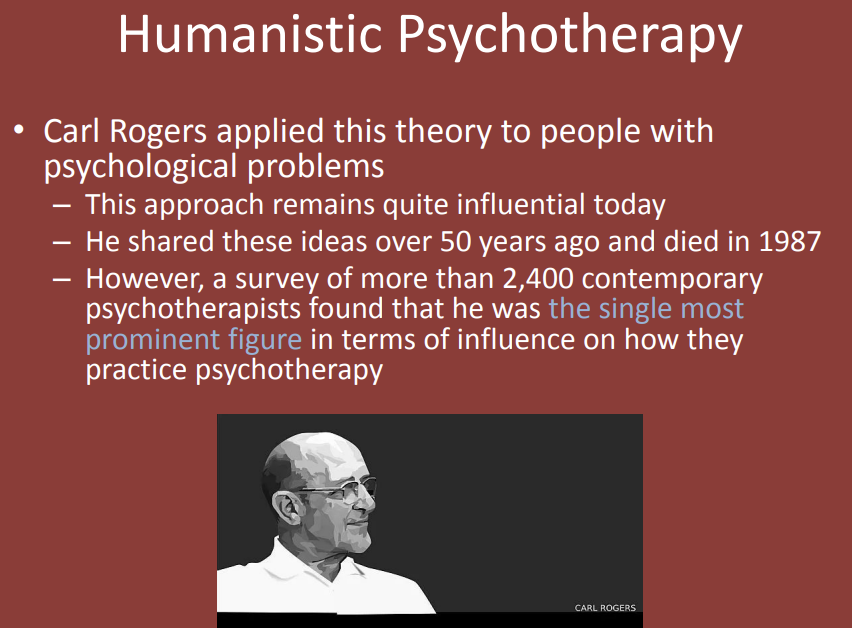
Who was the most prominent figure in terms of influencing how psychotherapy is practiced? (Humanistic Psychotherapy)
Carl Rogers was the most prominent figure influencing how psychotherapy is practiced, according to a survey of over 2,400 contemporary psychotherapists.
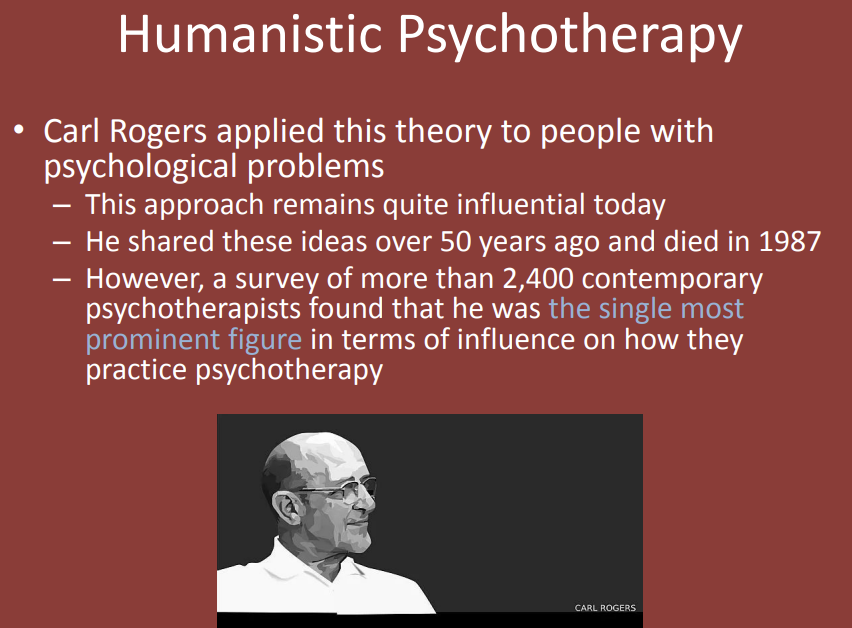
What does the term "humanistic" refer to in psychotherapy? (Humanistic Psychotherapy)
The term "humanistic" refers to a family of therapies created by Carl Rogers and his followers, such as nondirective, client-centered, and person-centered therapy.
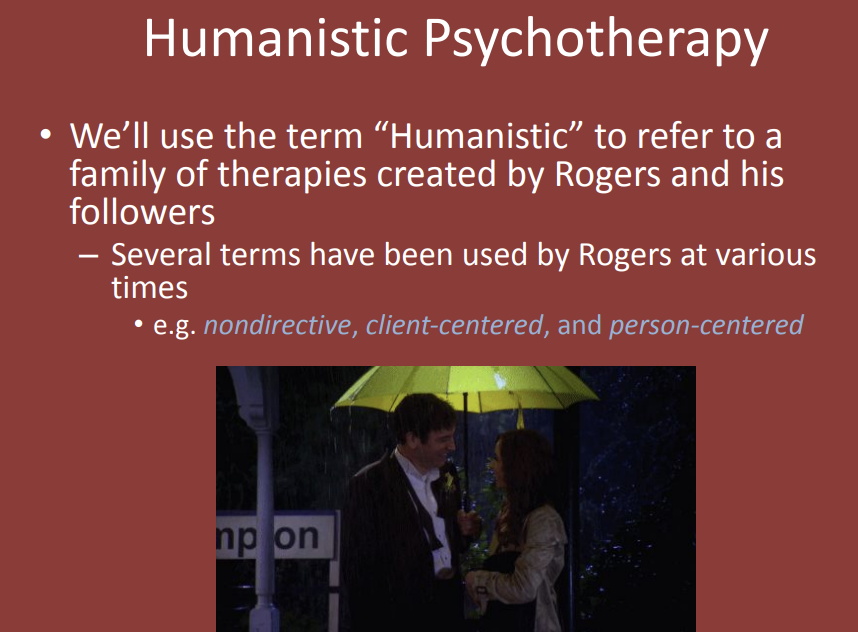
What terms were used by Carl Rogers at various times to describe his approach? (Humanistic Psychotherapy)
Carl Rogers used terms such as nondirective, client-centered, and person-centered to describe his approach to therapy.
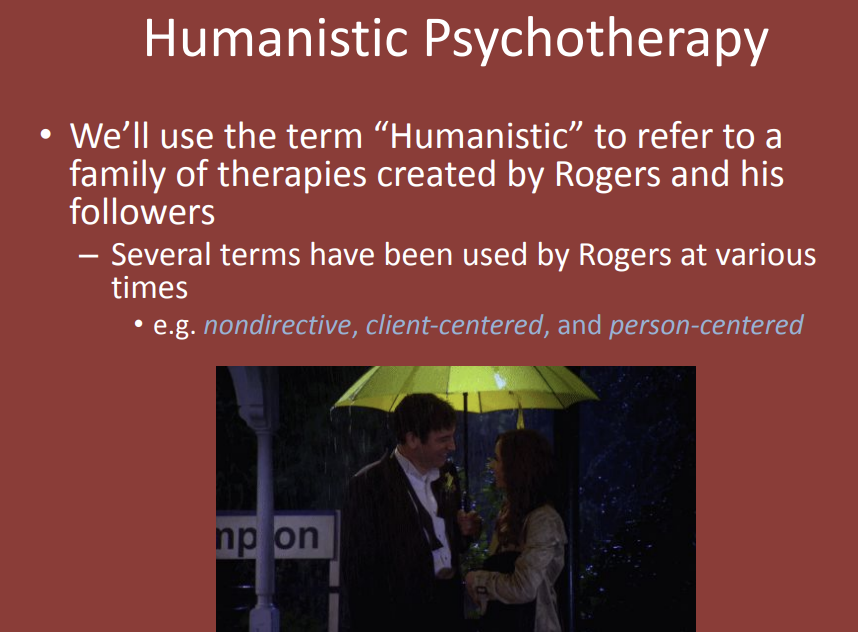
What do humanists assume people arrive with? (Humanistic Concepts: Clinical Implications)
Humanists assume that people arrive with an inborn tendency to grow.

What do humanists call the inborn tendency to grow? (Humanistic Concepts: Clinical Implications)
Humanists call it self-actualization.
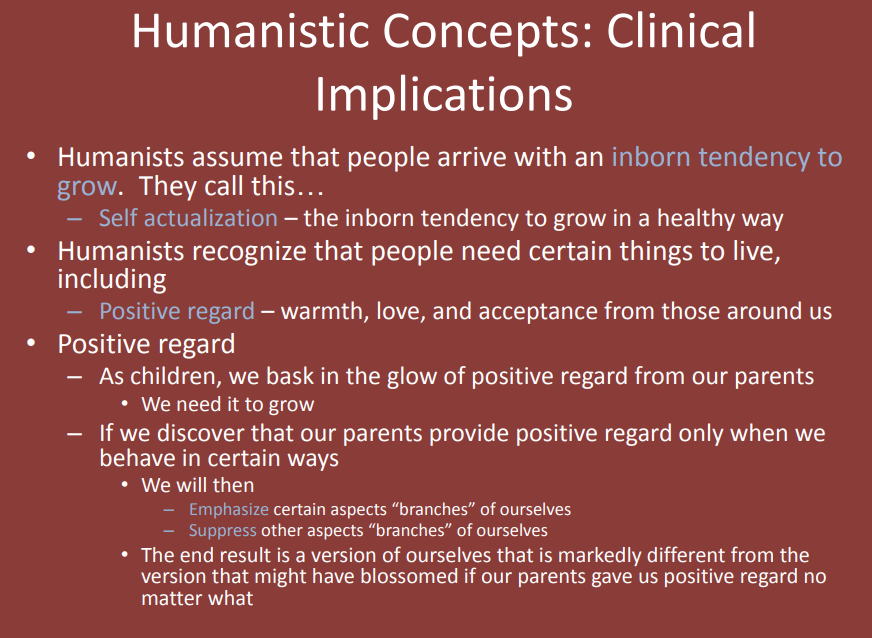
What is self-actualization? (Humanistic Concepts: Clinical Implications)
Self-actualization is the inborn tendency to grow in a healthy way and reach one's full potential.
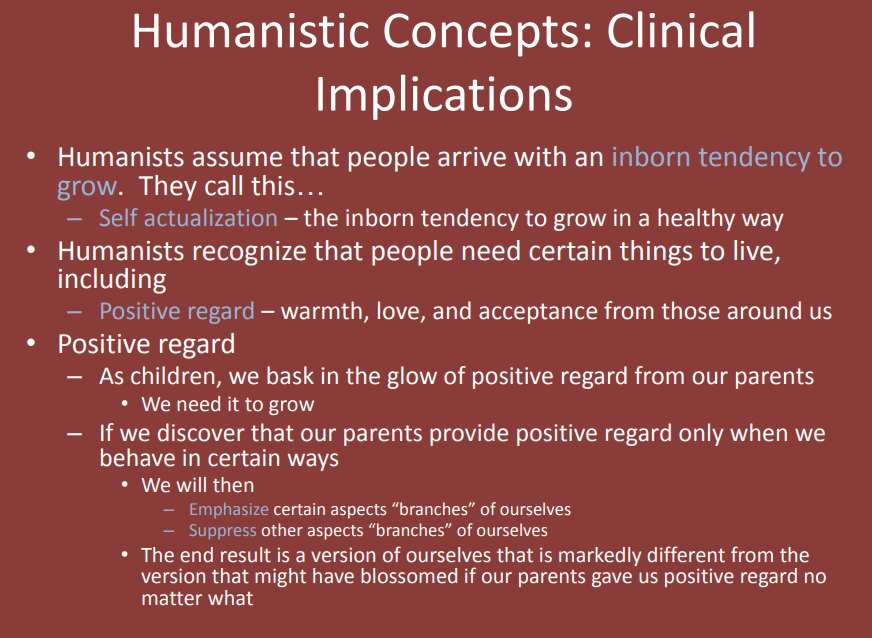
What do humanists recognize that people need in order to live? (Humanistic Concepts: Clinical Implications)
Humanists recognize that people need positive regard, which includes warmth, love, and acceptance from those around them.
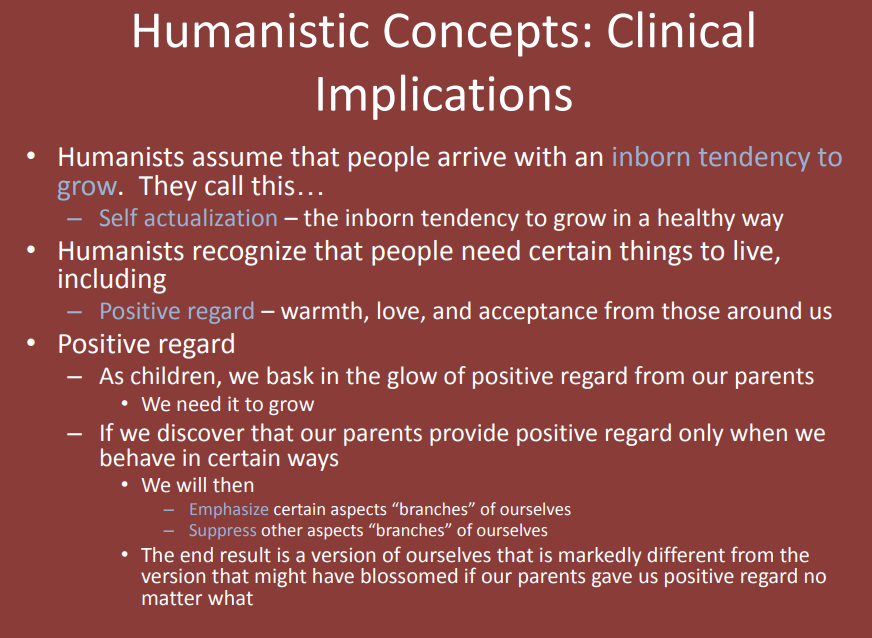
What is positive regard? (Humanistic Concepts: Clinical Implications)
Positive regard is the warmth, love, and acceptance that people, especially children, receive from others, which helps them grow.
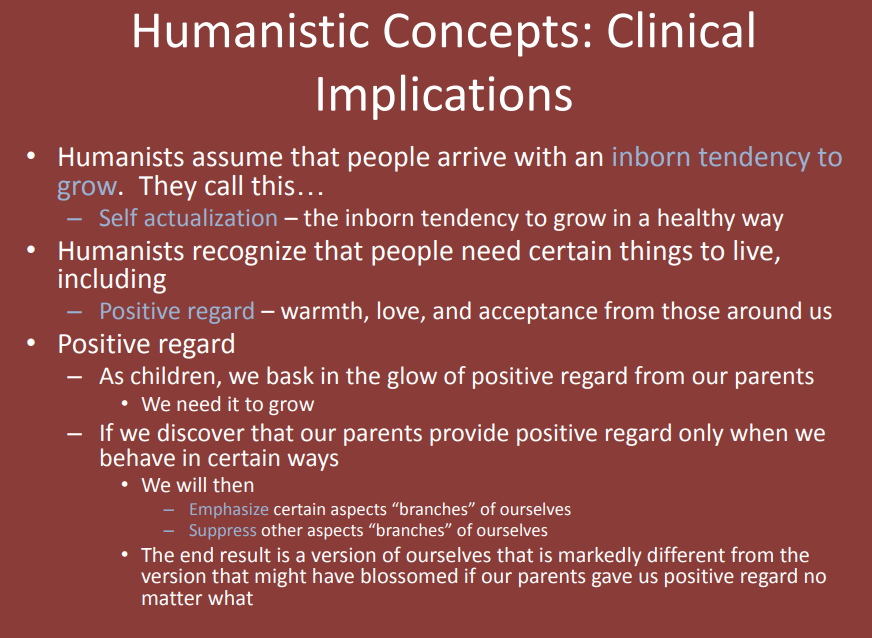
What happens if we discover that our parents provide positive regard only under certain conditions? (Humanistic Concepts: Clinical Implications)
If parents provide positive regard only when we behave in certain ways, we:
Emphasize certain aspects of ourselves.
Suppress other aspects of ourselves.
Develop a self-concept that is different from what might have naturally blossomed if we received unconditional positive regard.
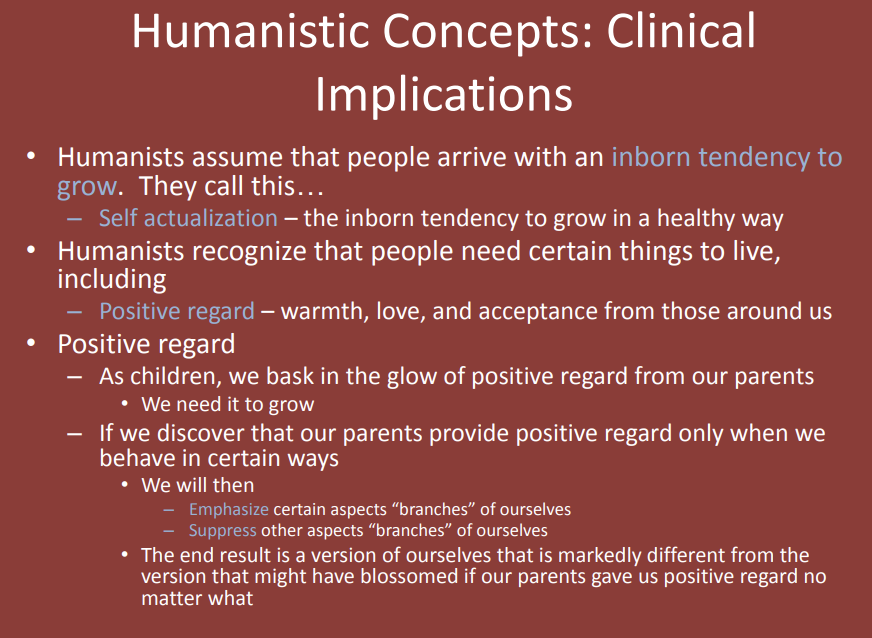
What is the primary goal of humanistic psychotherapy? (Goals of Humanistic Psychotherapy)
The primary goal is to foster self-actualization.
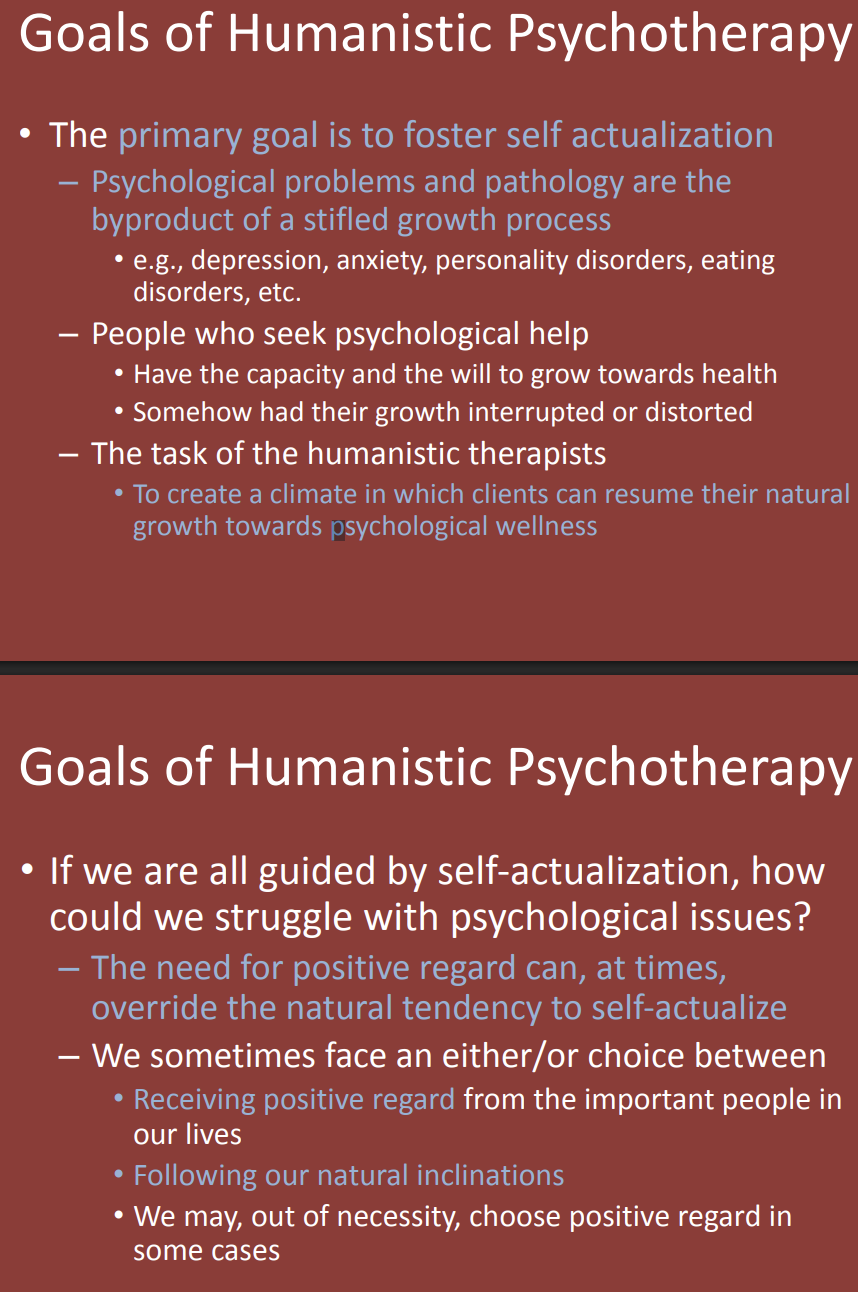
What are psychological problems and pathology the byproduct of? (Goals of Humanistic Psychotherapy)
Psychological problems and pathology are the byproduct of a stifled growth process.
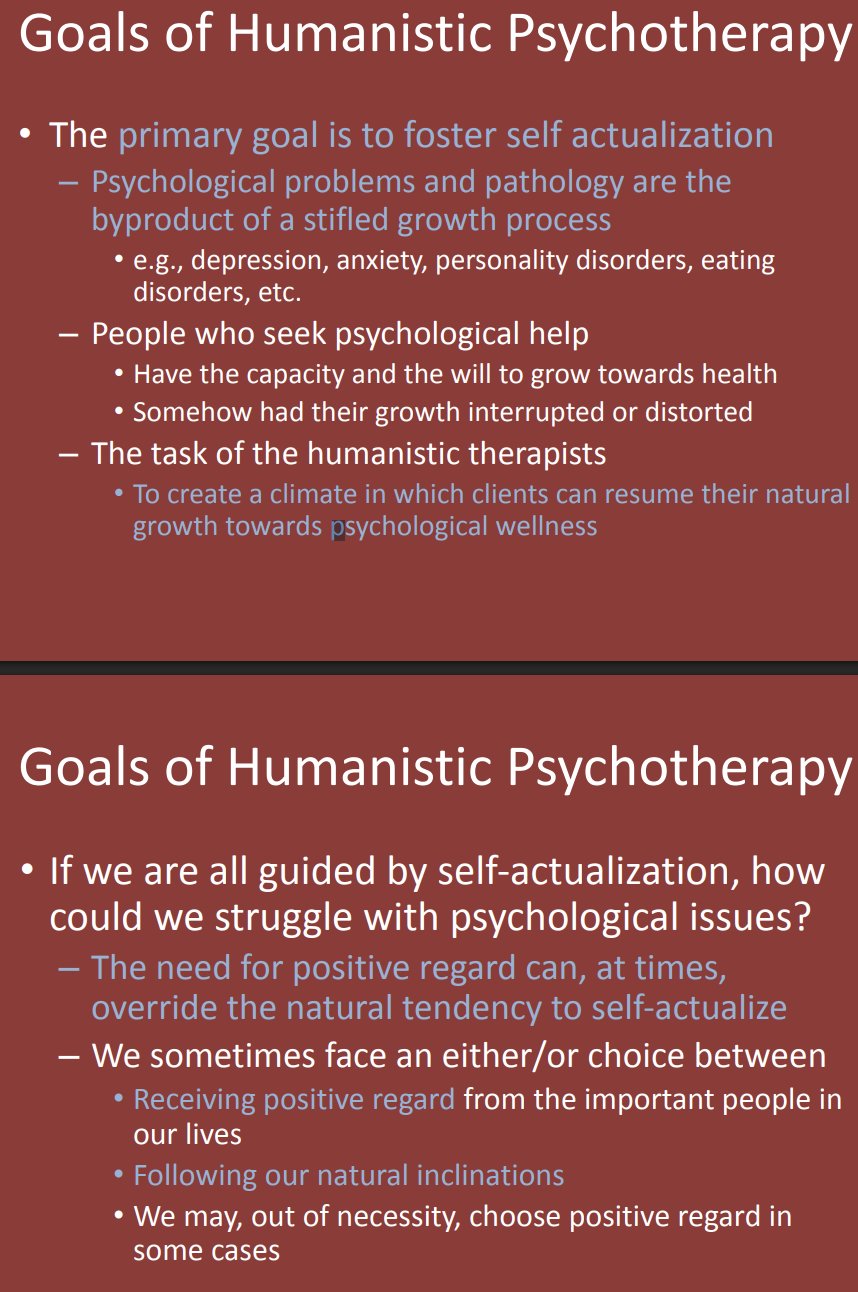
What is the task of humanistic therapists?(Goals of Humanistic Psychotherapy)
The task of humanistic therapists is to create a climate where clients can resume their natural growth toward psychological wellness.
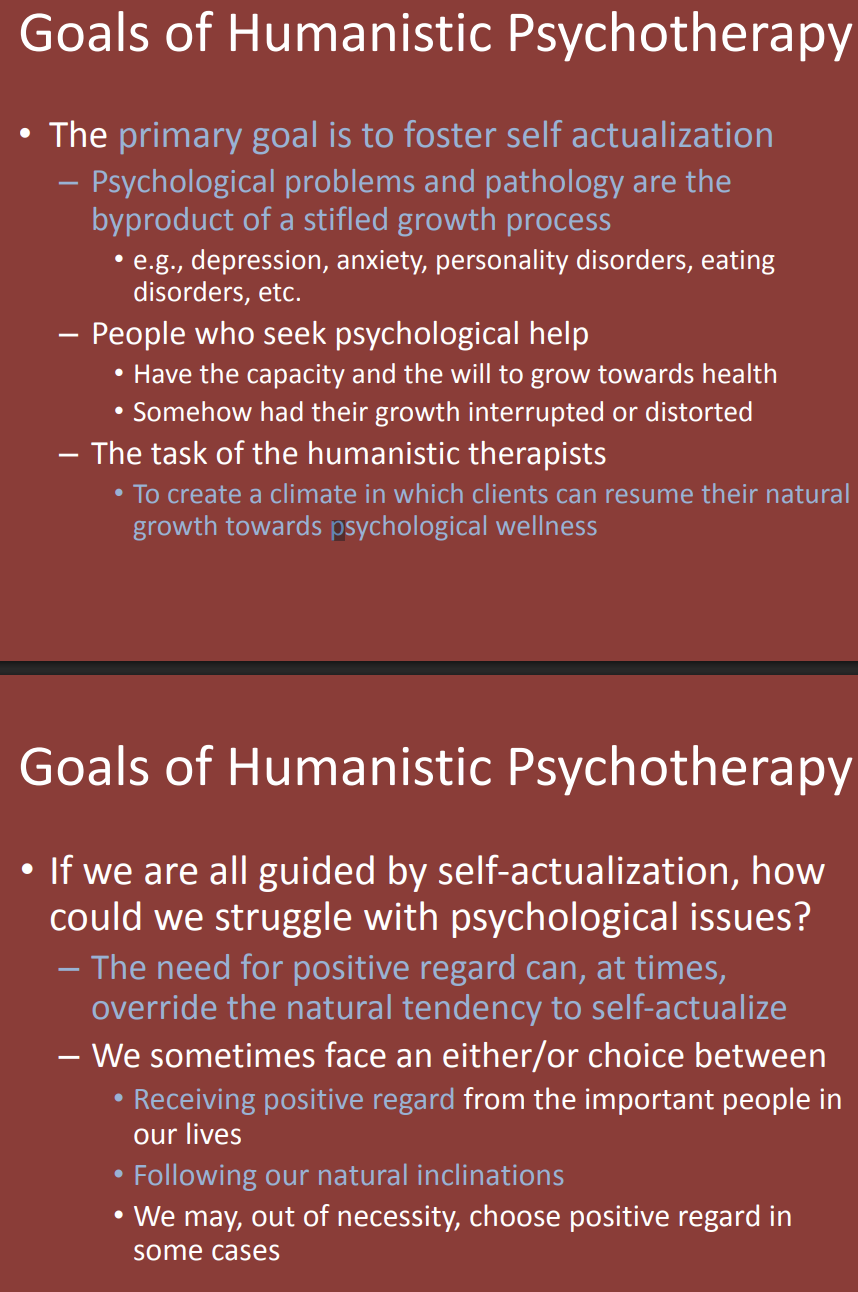
How can we struggle with psychological issues if we are guided by self-actualization? (Goals of Humanistic Psychotherapy)
We struggle when our need for positive regard overrides our natural tendency to self-actualize, forcing us to choose between:
Receiving positive regard from important people.
Following our natural inclinations.
If we prioritize positive regard, it can interrupt our growth and lead to psychological issues.
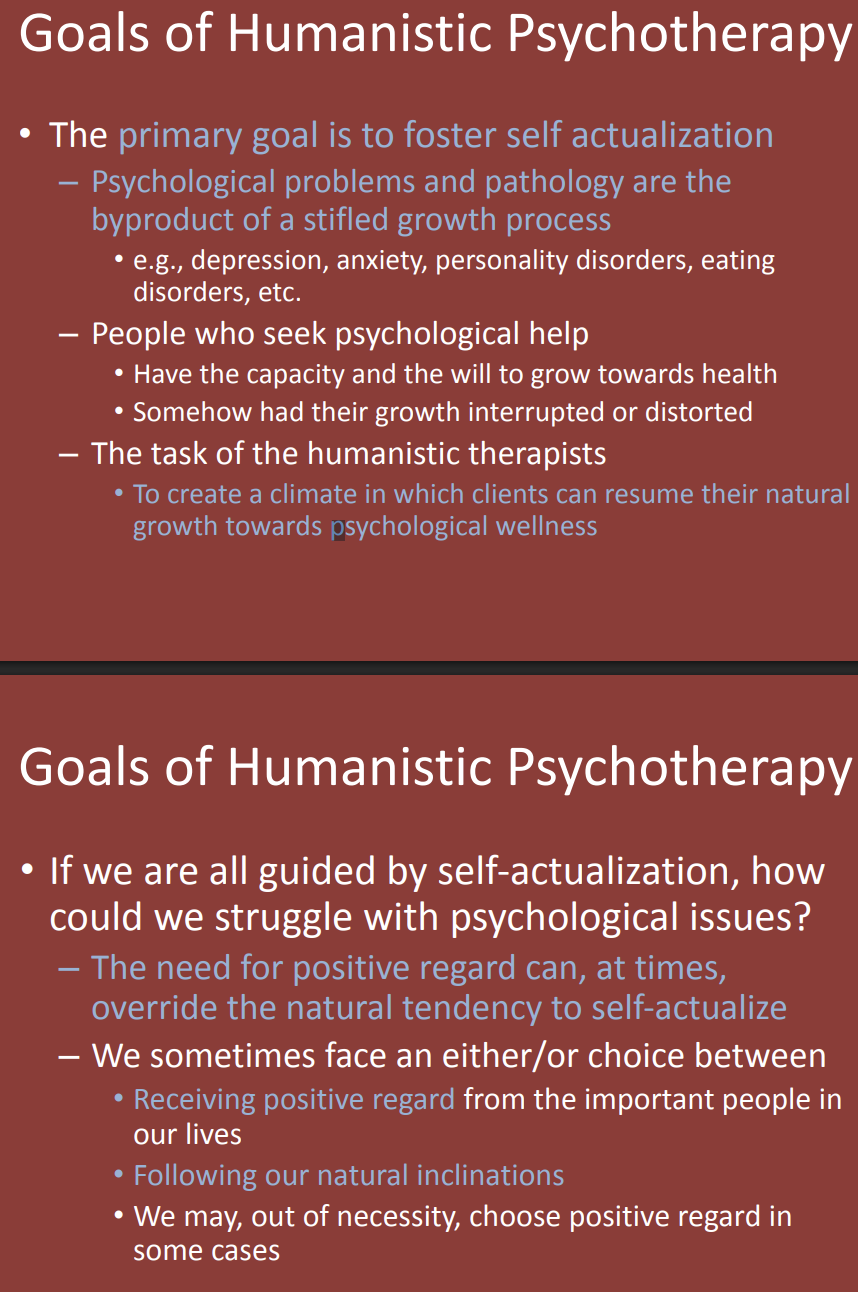
What problems arise when positive regard is conditional rather than unconditional? (Conditional Positive Regard)
It can stifle self-actualization, leading individuals to stray from their true selves to gain acceptance, which contributes to psychological problems.

What is conditional positive regard? (Conditional Positive Regard)
It is when acceptance or love is given "only if" a person meets certain conditions or expectations.
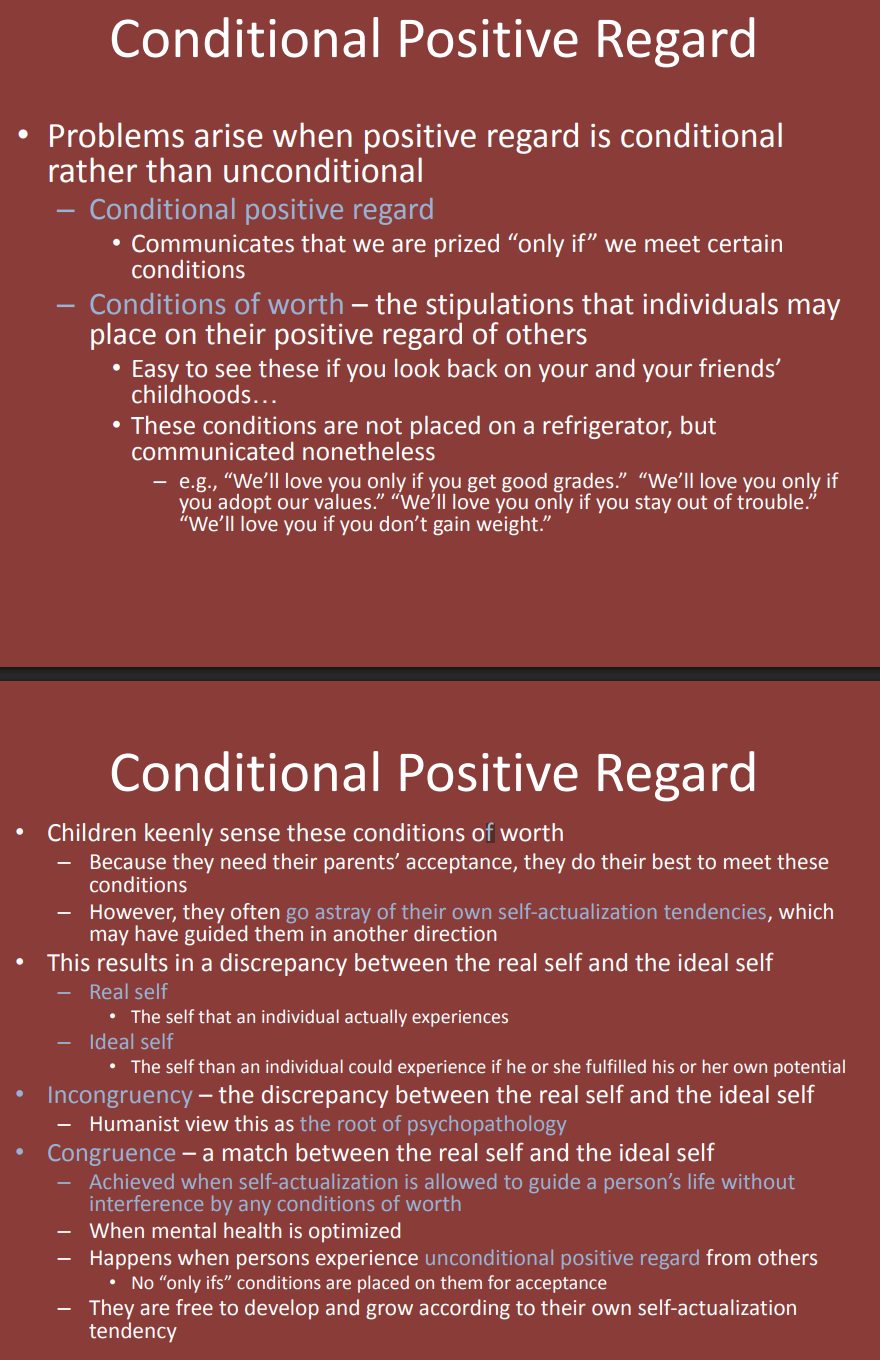
What are conditions of worth? (Conditional Positive Regard)
These are the stipulations or expectations that people (especially children) believe they must meet to receive love or acceptance.
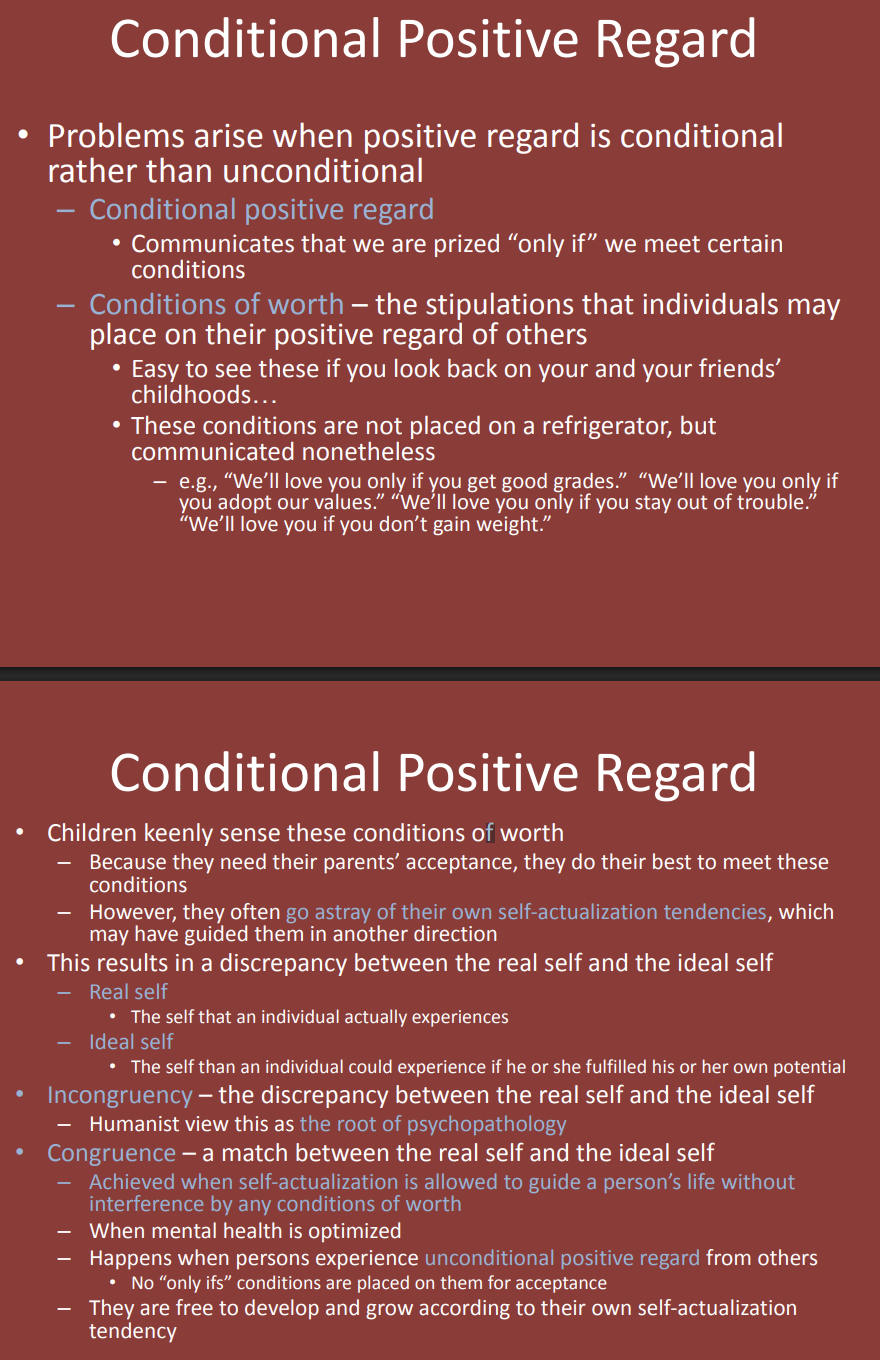
How do children go astray under conditional positive regard? (Conditional Positive Regard)
To gain acceptance, children prioritize meeting conditions of worth over following their natural self-actualization tendencies, leading them away from their true selves.
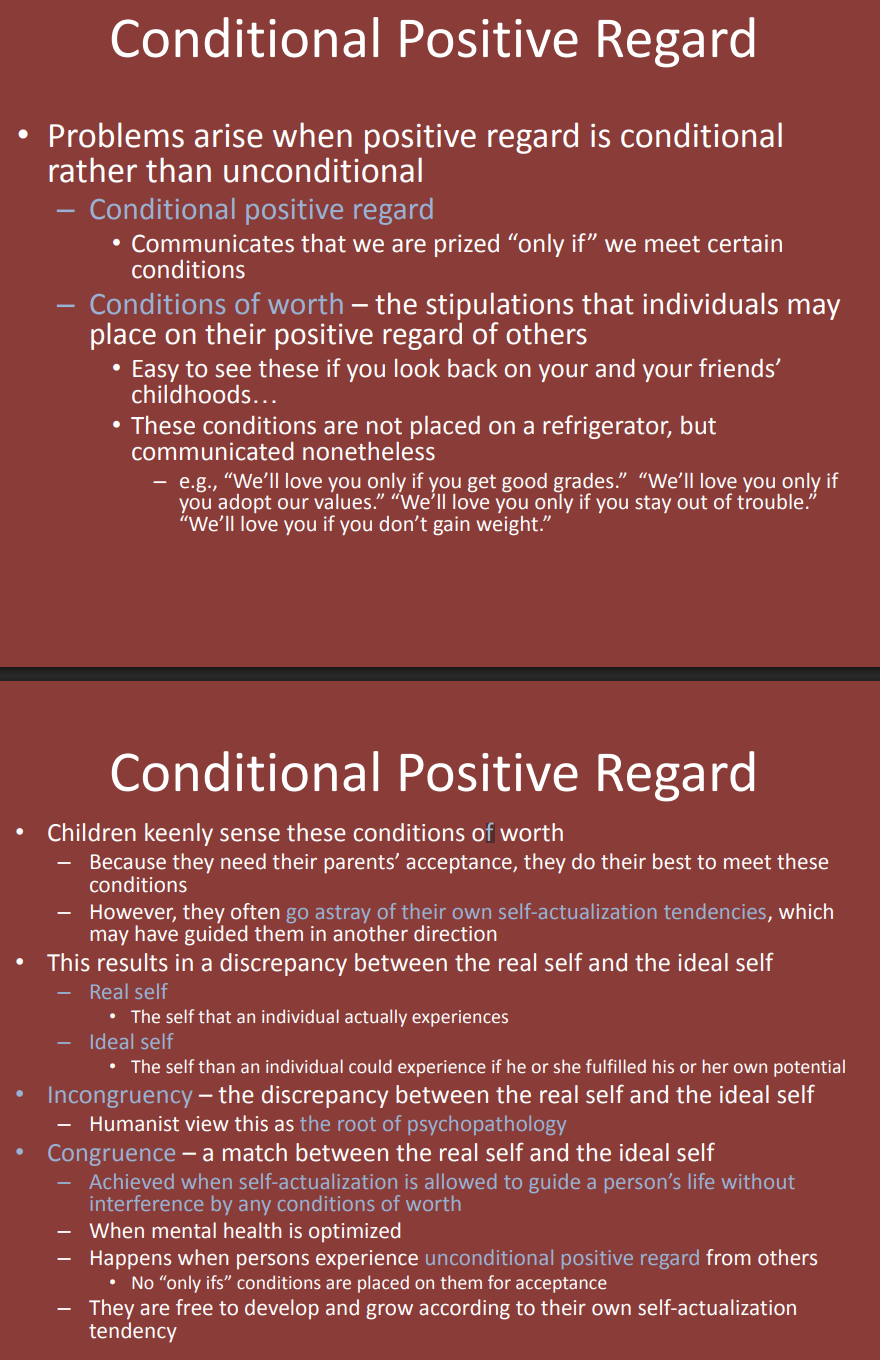
What is the real self vs. the ideal self? (Conditional Positive Regard)
Real self: The self an individual actually experiences.
Ideal self: The self an individual could experience if they fulfilled their full potential.
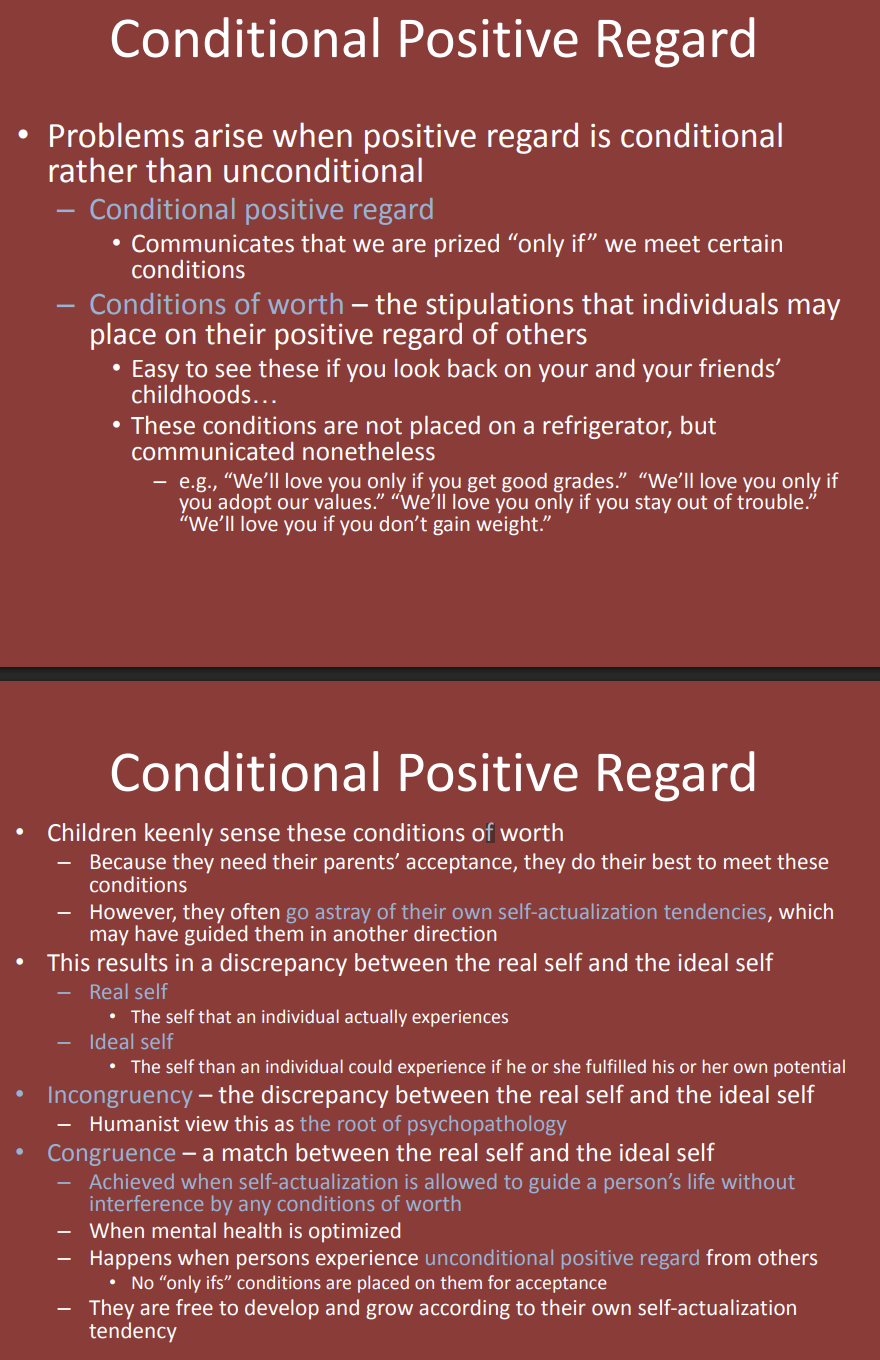
What is incongruency? (Conditional Positive Regard)
It’s the discrepancy between the real self and the ideal self—seen as the root of psychopathology in humanistic theory.
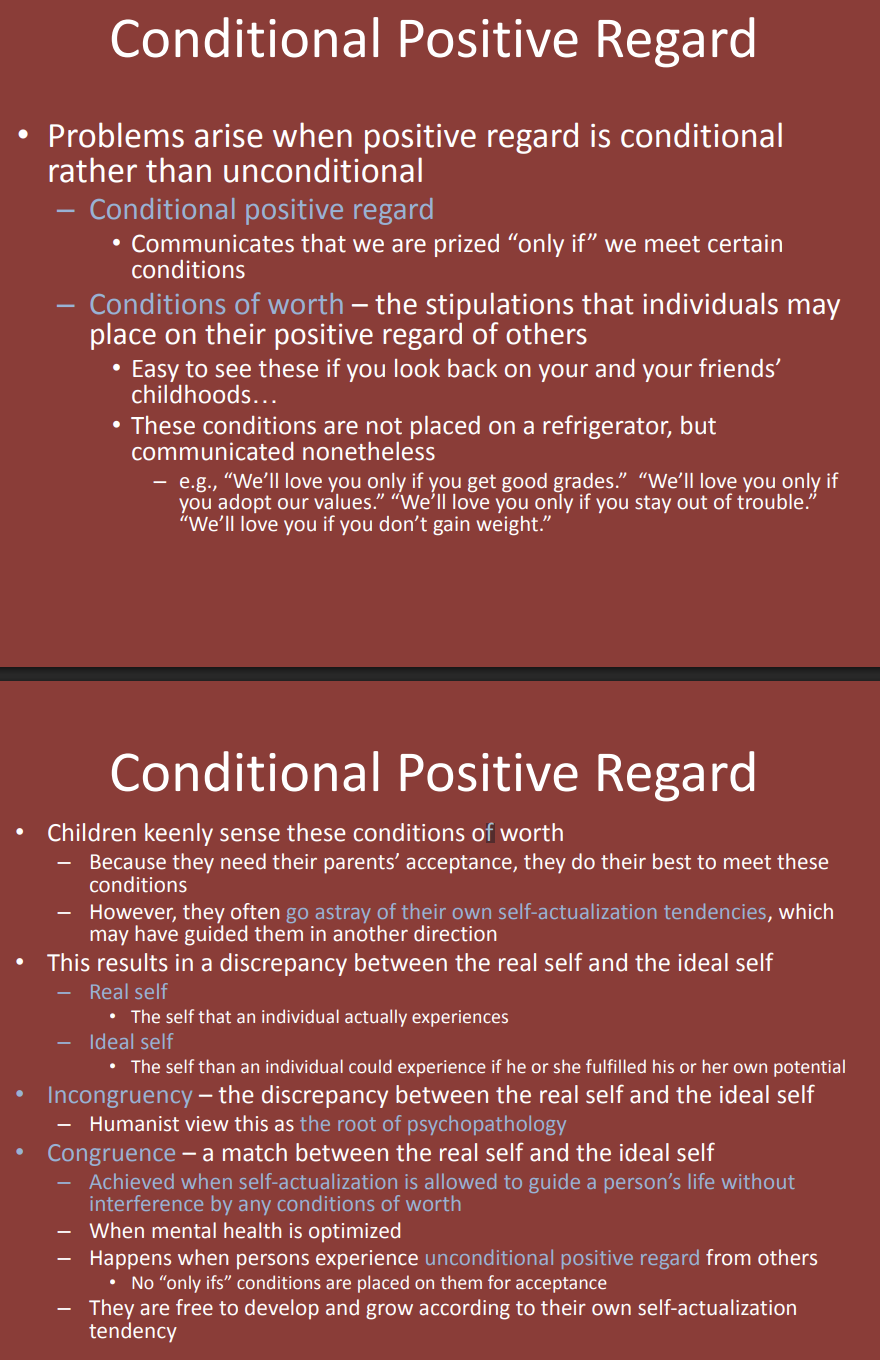
What is congruence? (Conditional Positive Regard)
Congruence is a match between the real and ideal self, achieved when self-actualization is supported without conditions of worth—this leads to optimal mental health.
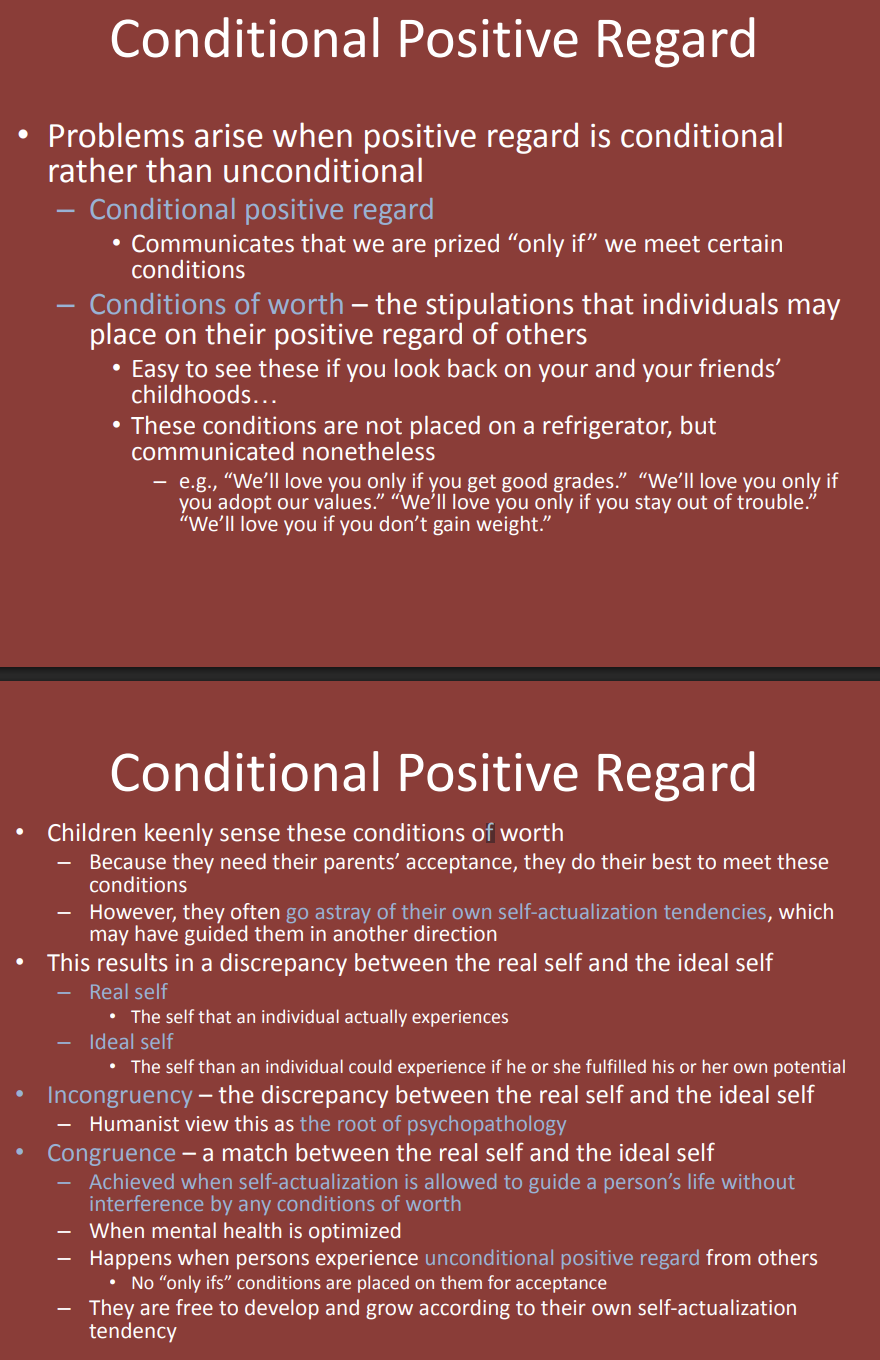
How do conditions of worth become incorporated into our view of ourselves? (Conditions of Worth)
They start as external expectations from others but eventually become internalized, shaping how we evaluate ourselves.
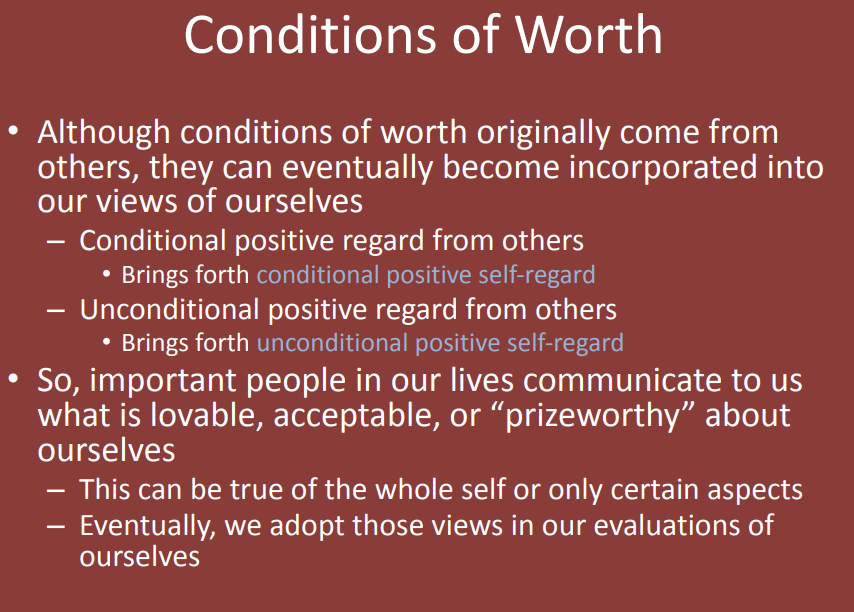
What happens when we receive conditional positive regard from others? (Conditions of Worth)
It leads to conditional positive self-regard, meaning we only accept ourselves if we meet certain standards.
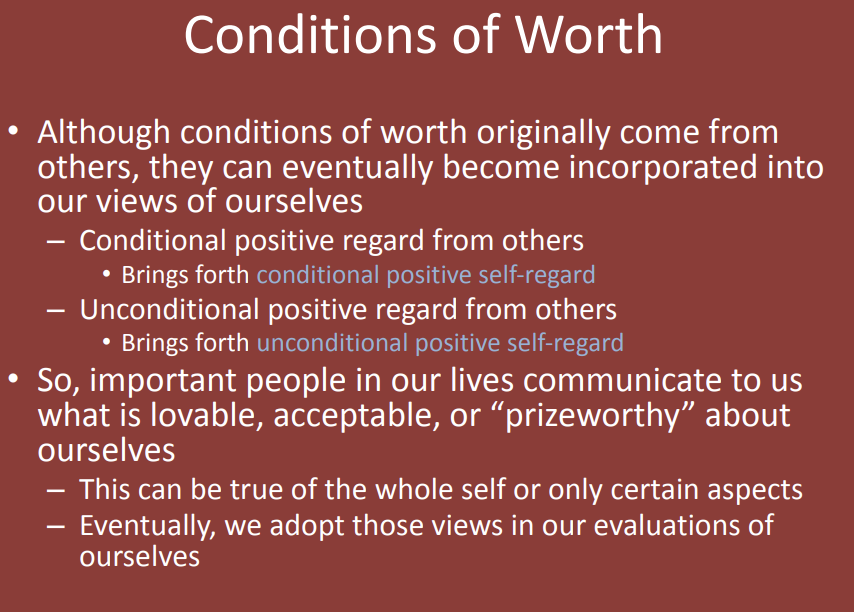
What happens when we receive unconditional positive regard from others? (Conditions of Worth)
It fosters unconditional positive self-regard, allowing us to accept ourselves fully, without conditions.
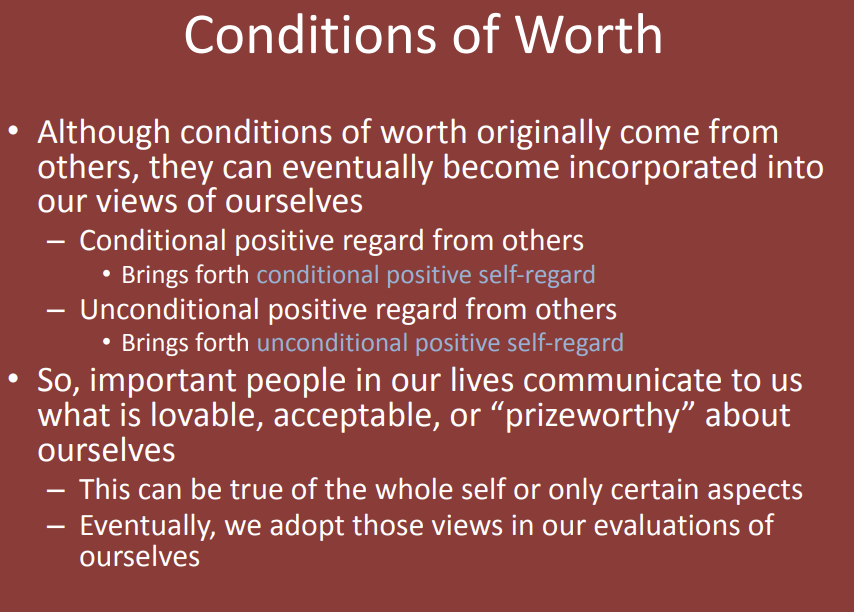
What do important people in our lives communicate to us? (Conditions of Worth)
They shape what we see as lovable, acceptable, or "prizeworthy", influencing how we evaluate ourselves—either in full or only in certain aspects.
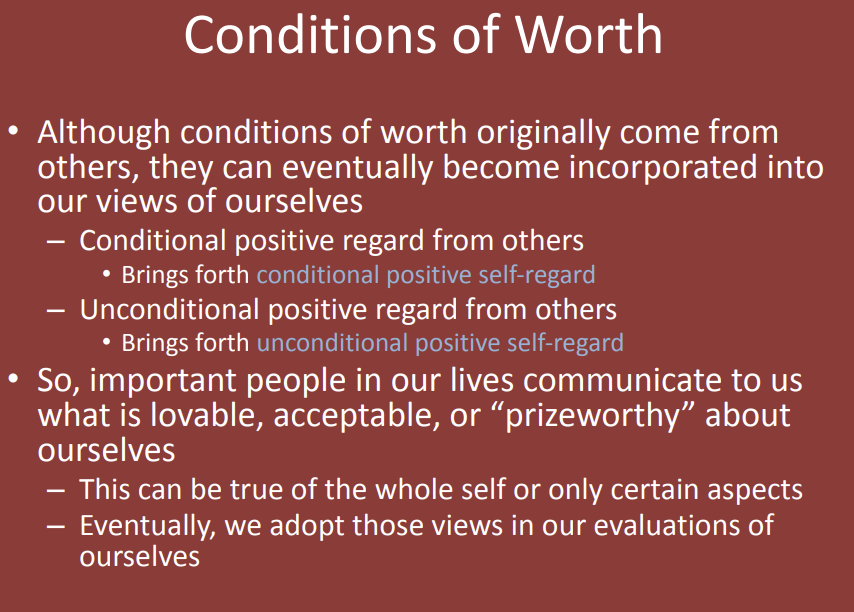
How does the therapist foster the client’s self-healing tendencies? (Elements of Humanistic Psychotherapy)
By creating a therapist-client relationship characterized by:
Empathy – Understanding and sharing the client’s feelings.
Unconditional Positive Regard – Accepting the client without judgment.
Genuineness – Being authentic and transparent in interactions.
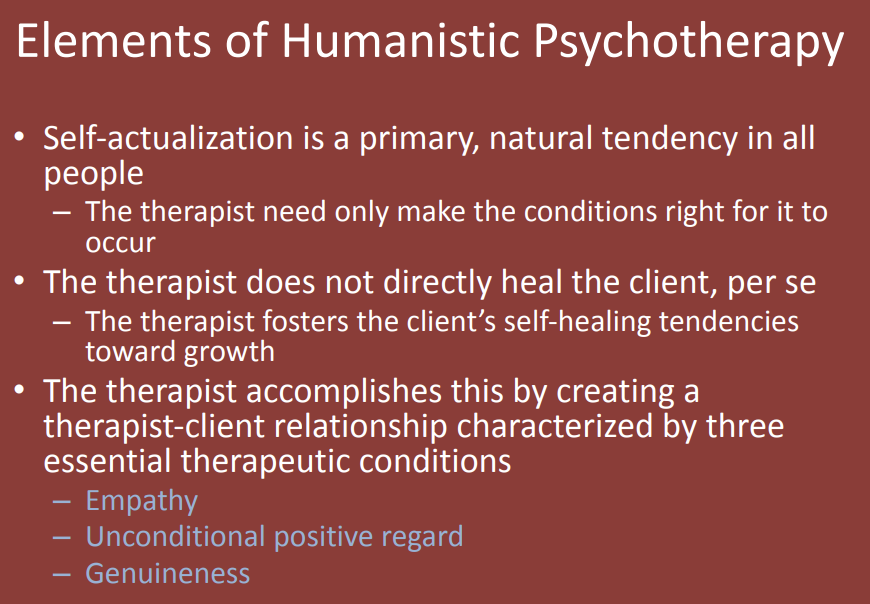
What is empathy in the context of therapy?
(Empathy)
Empathy is the therapist’s ability to deeply and nonjudgmentally understand the client’s emotions and experiences from the client’s perspective.
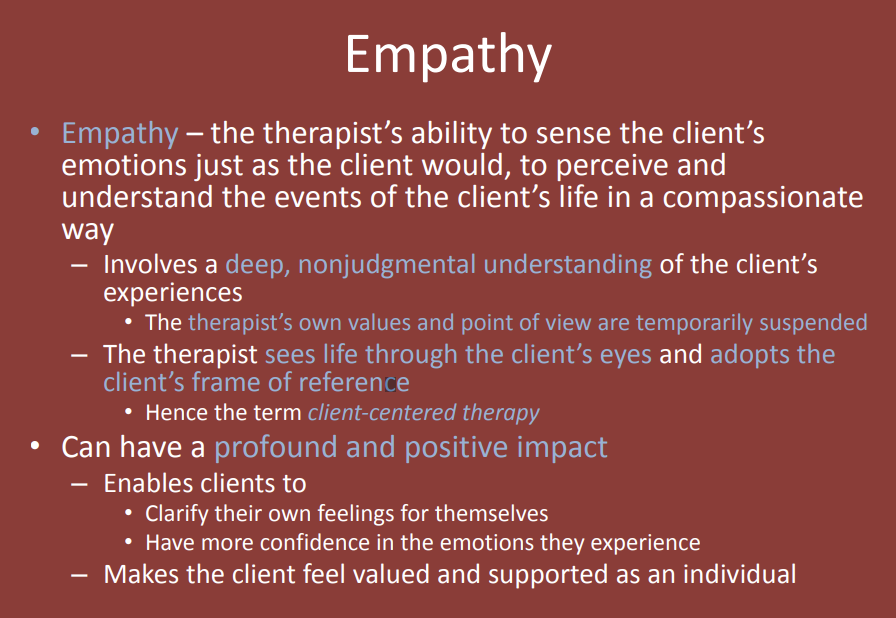
How is empathy connected to client-centered therapy?
(Empathy)
Empathy is a core component of client-centered therapy, where the therapist adopts the client’s frame of reference and views the world through the client’s eyes.

How can empathy have a profound and positive impact on clients?
(Empathy)
Empathy helps clients clarify their feelings, feel more confident in their emotions, and feel genuinely valued and supported.
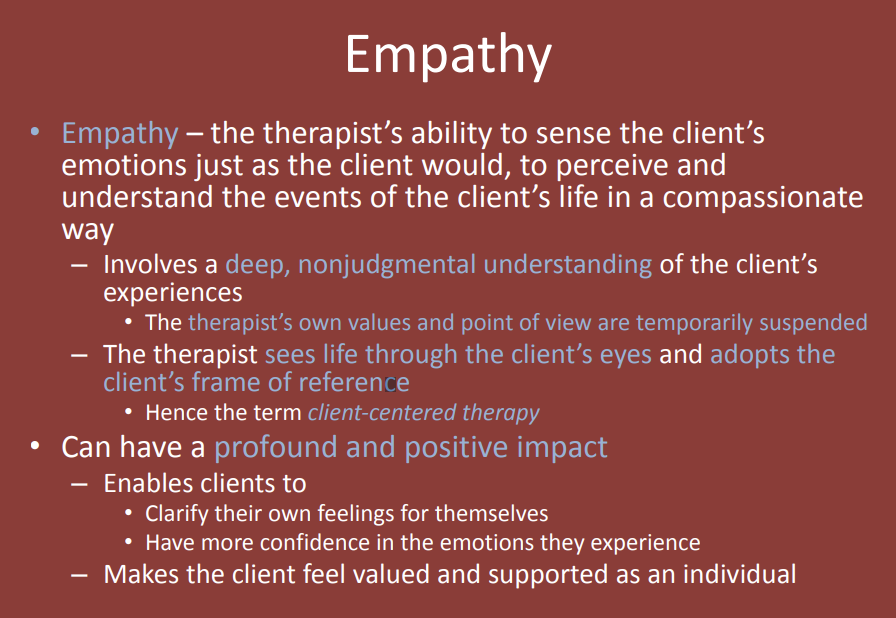
What is unconditional positive regard? (Unconditional Positive Regard)
It is the full acceptance of another person without any conditions or stipulations, meaning they are valued "no matter what."
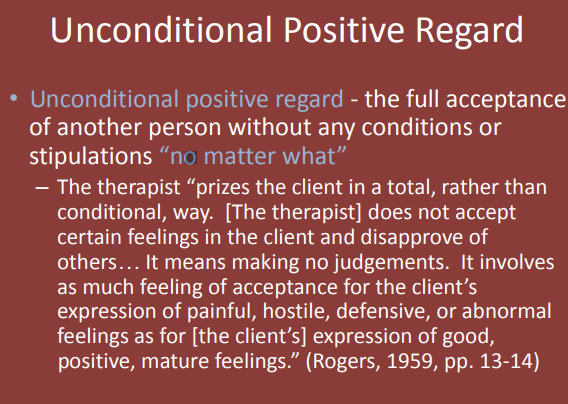
What does unconditional positive regard allow clients to grow in? (Unconditional Positive Regard)
It allows clients to grow in a purely self-directed way, without fear of losing acceptance or respect.
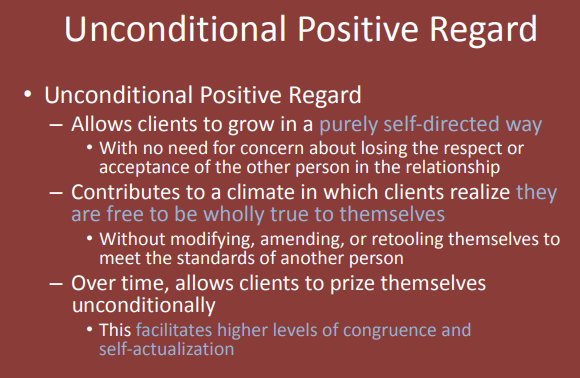
What kind of climate does unconditional positive regard contribute to? (Unconditional Positive Regard)
It creates a climate where clients feel free to be wholly true to themselves without altering their identity to meet others' standards.
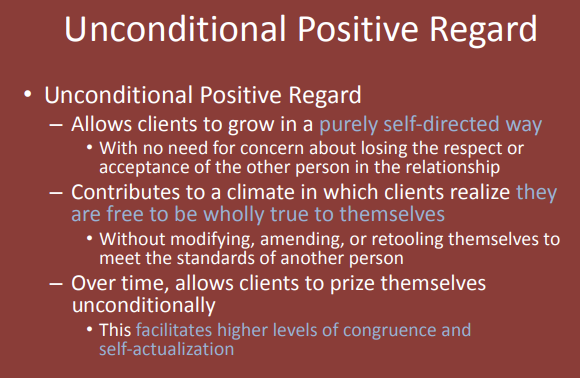
Over time, what does unconditional positive regard facilitate? (Unconditional Positive Regard)
It helps clients develop self-acceptance, leading to higher congruence and self-actualization.
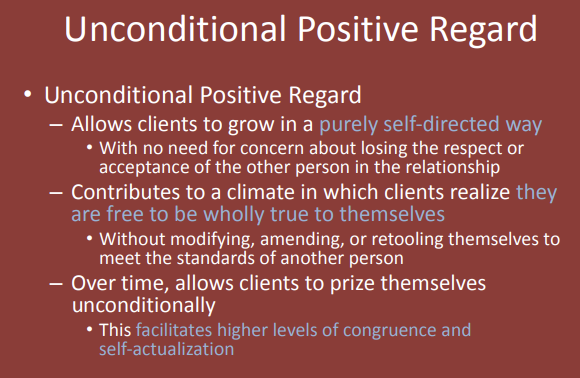
What types of relationships impede growth and cause individuals to drift from their true selves? (Unconditional Positive Regard)
Relationships where acceptance is conditional—where people value only specific traits, behaviors, or skills—impede growth and create a disconnect from one's authentic self.
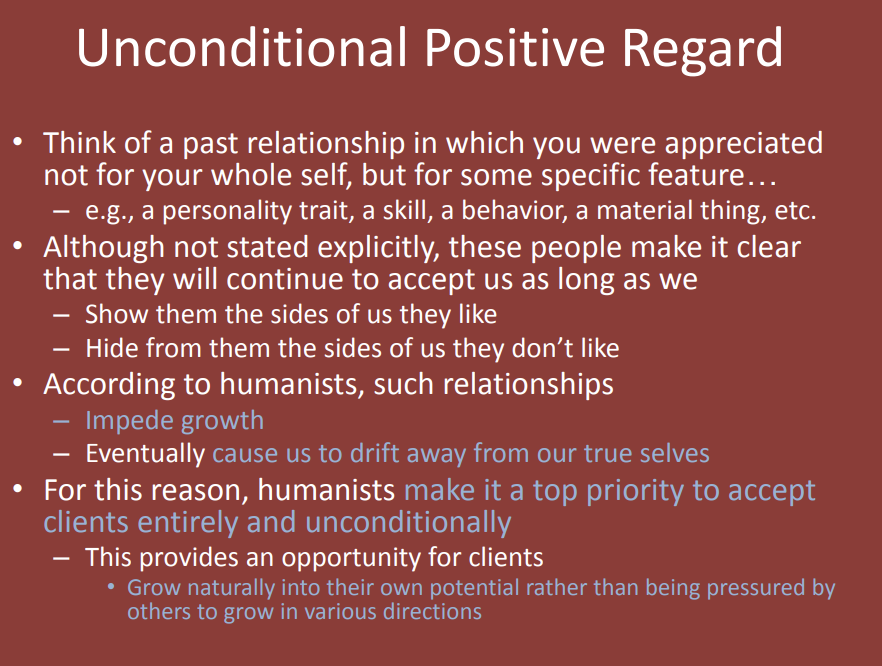
Why do humanists make it a priority to accept clients entirely and unconditionally? (Unconditional Positive Regard)
Because it provides clients the opportunity to grow naturally into their own potential rather than being pressured by others to conform to external expectations.
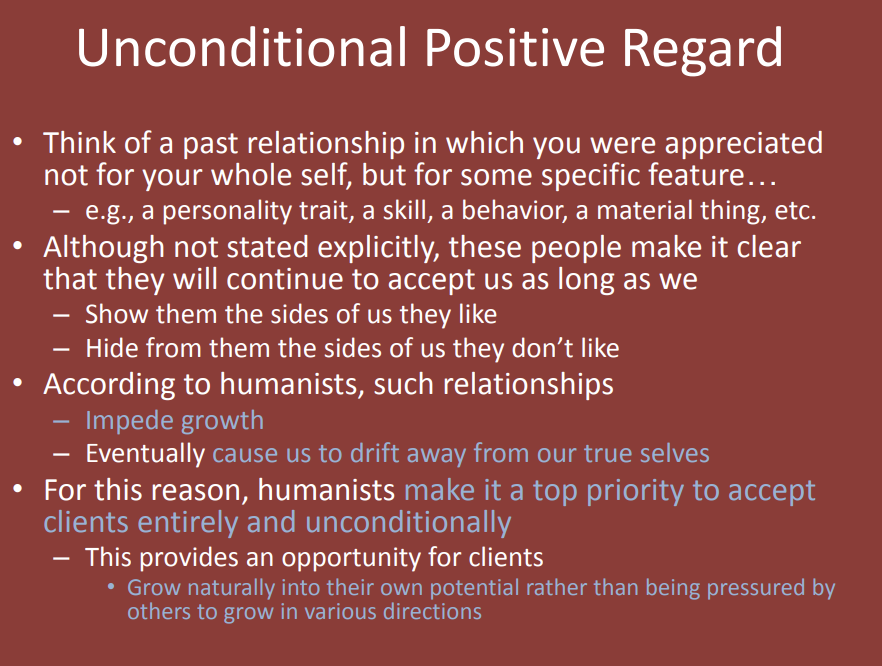
Why might empathy and unconditional positive regard be worthless? (Genuineness)
If they are not honest. They must be genuine rather than an act.
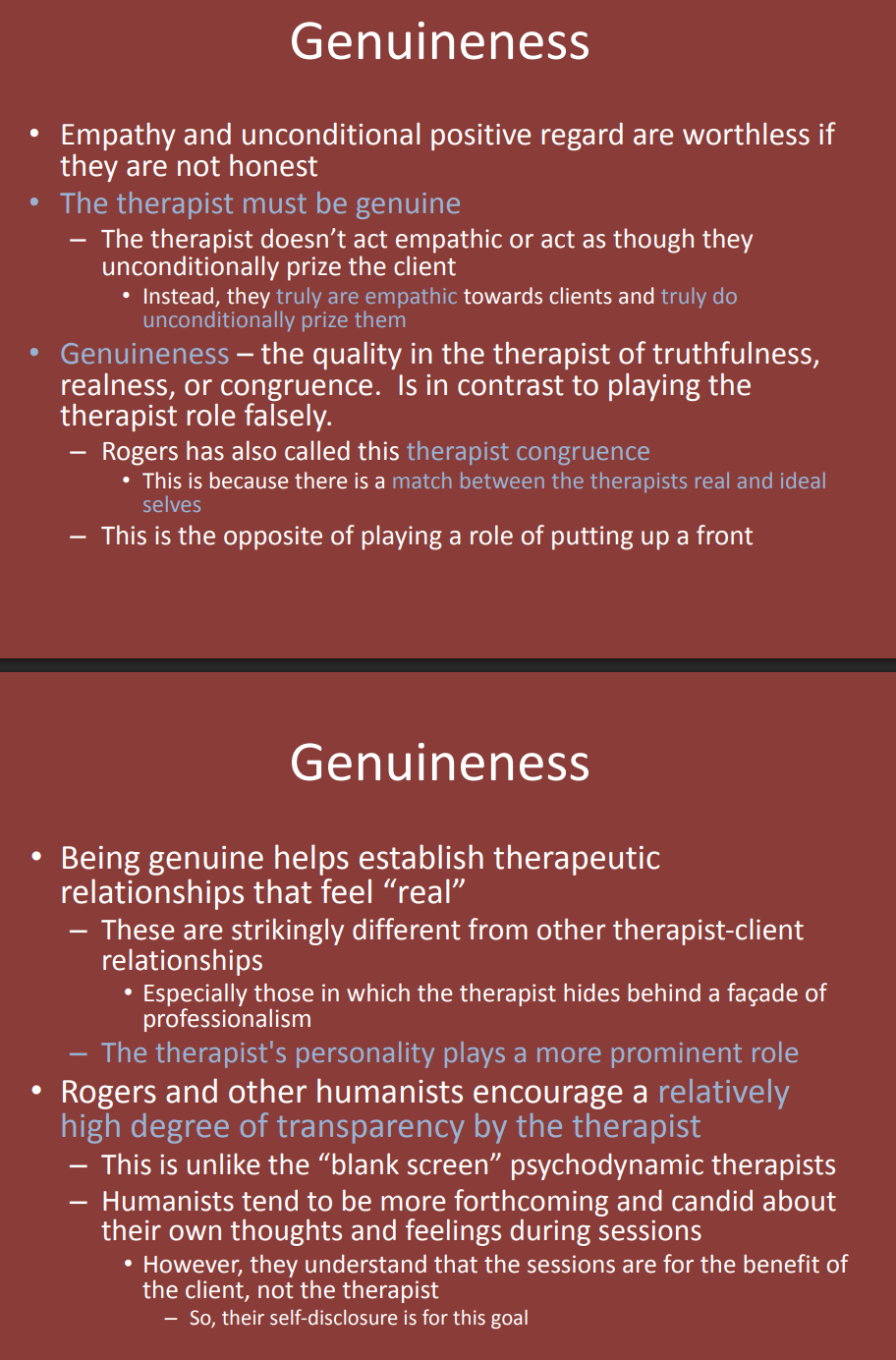
What is genuineness in humanistic therapy? (Genuineness)
It is the therapist's quality of truthfulness, realness, or congruence, contrasting with playing a false therapist role.
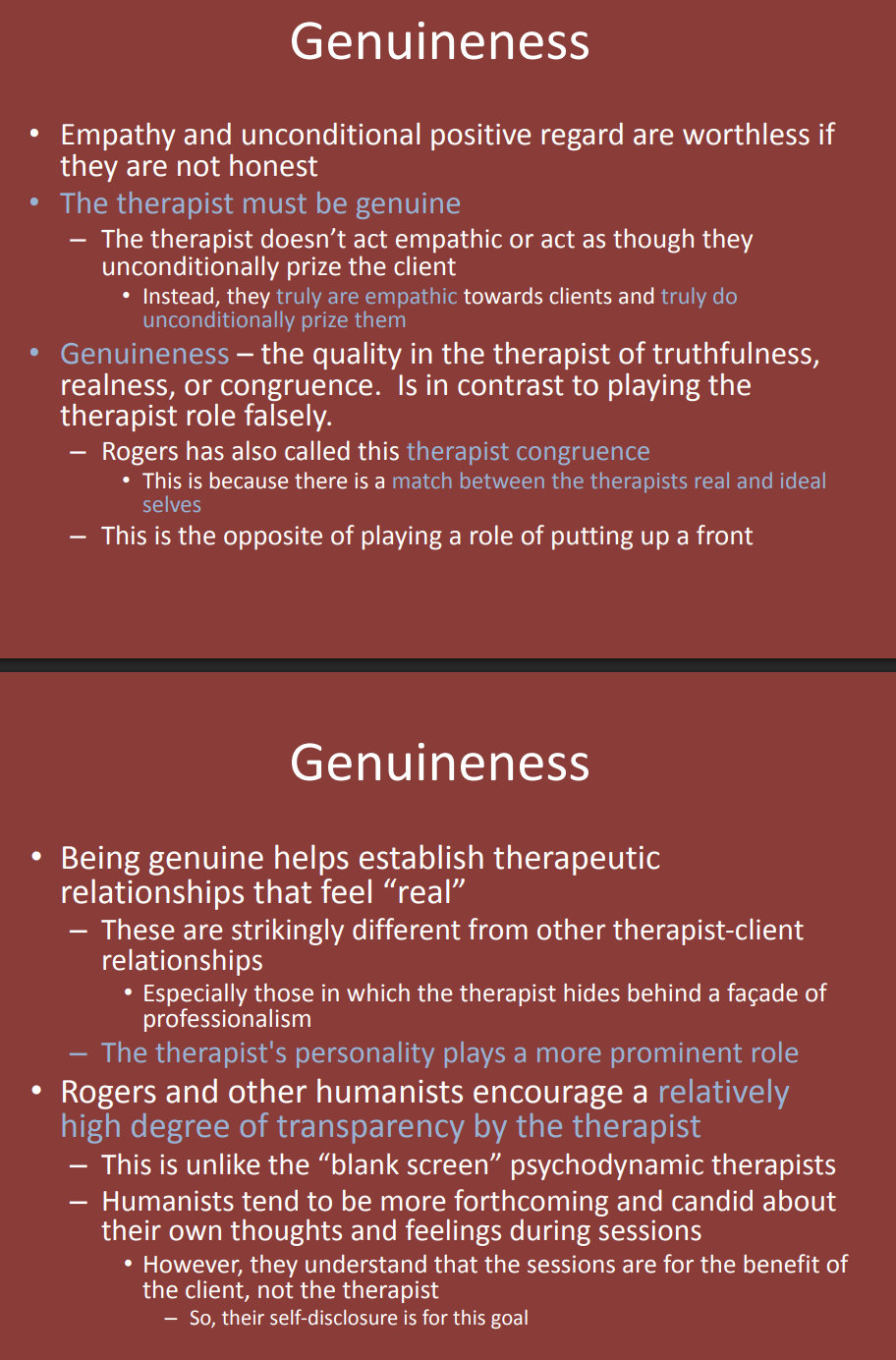
What did Rogers call genuineness and why? (Genuineness)
He called it "therapist congruence" because it reflects a match between the therapist’s real and ideal selves.
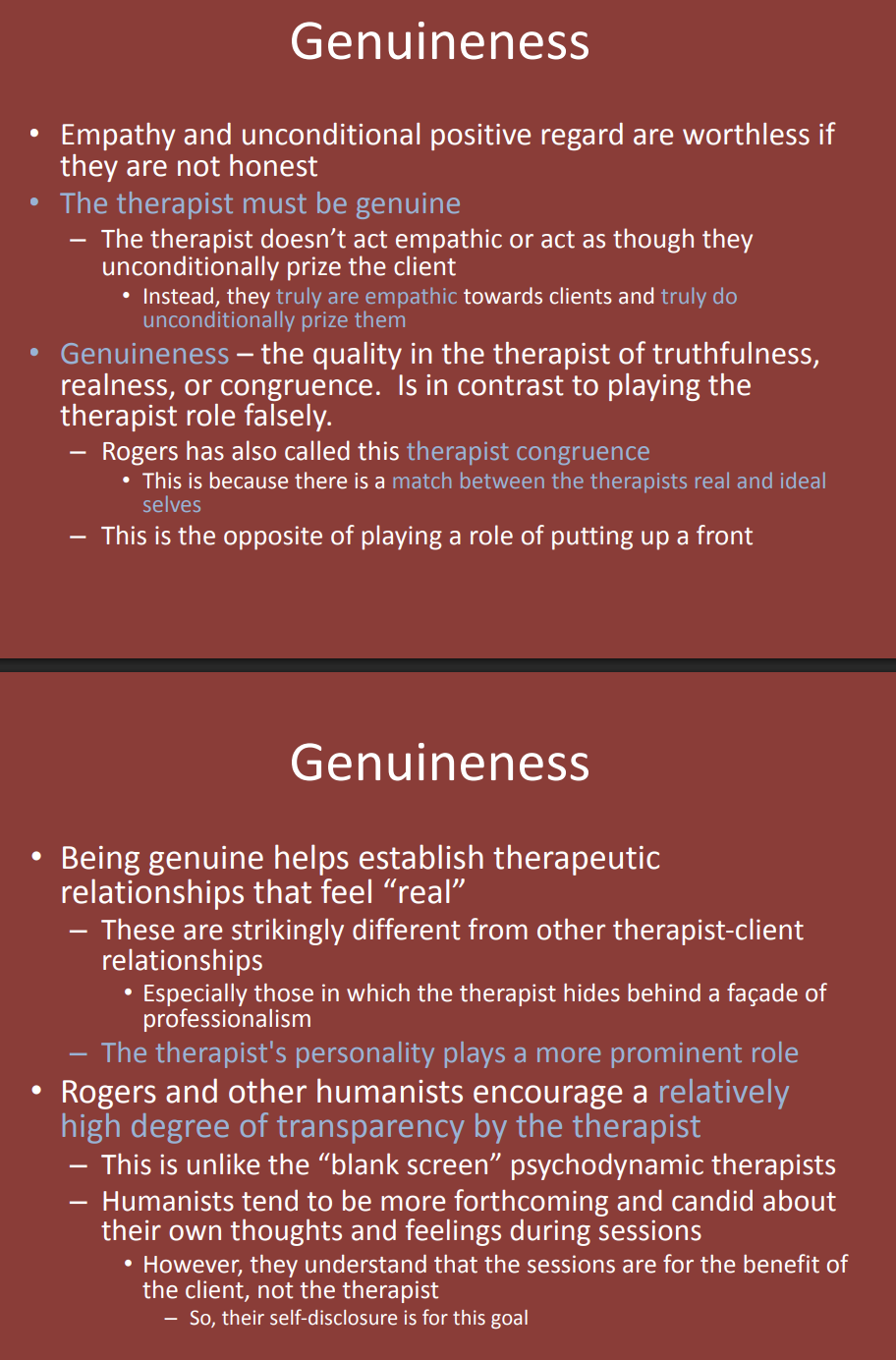
How does the therapist’s personality play a more prominent role in humanistic therapy? (Genuineness)
The therapist establishes a “real” therapeutic relationship instead of hiding behind a façade of professionalism.
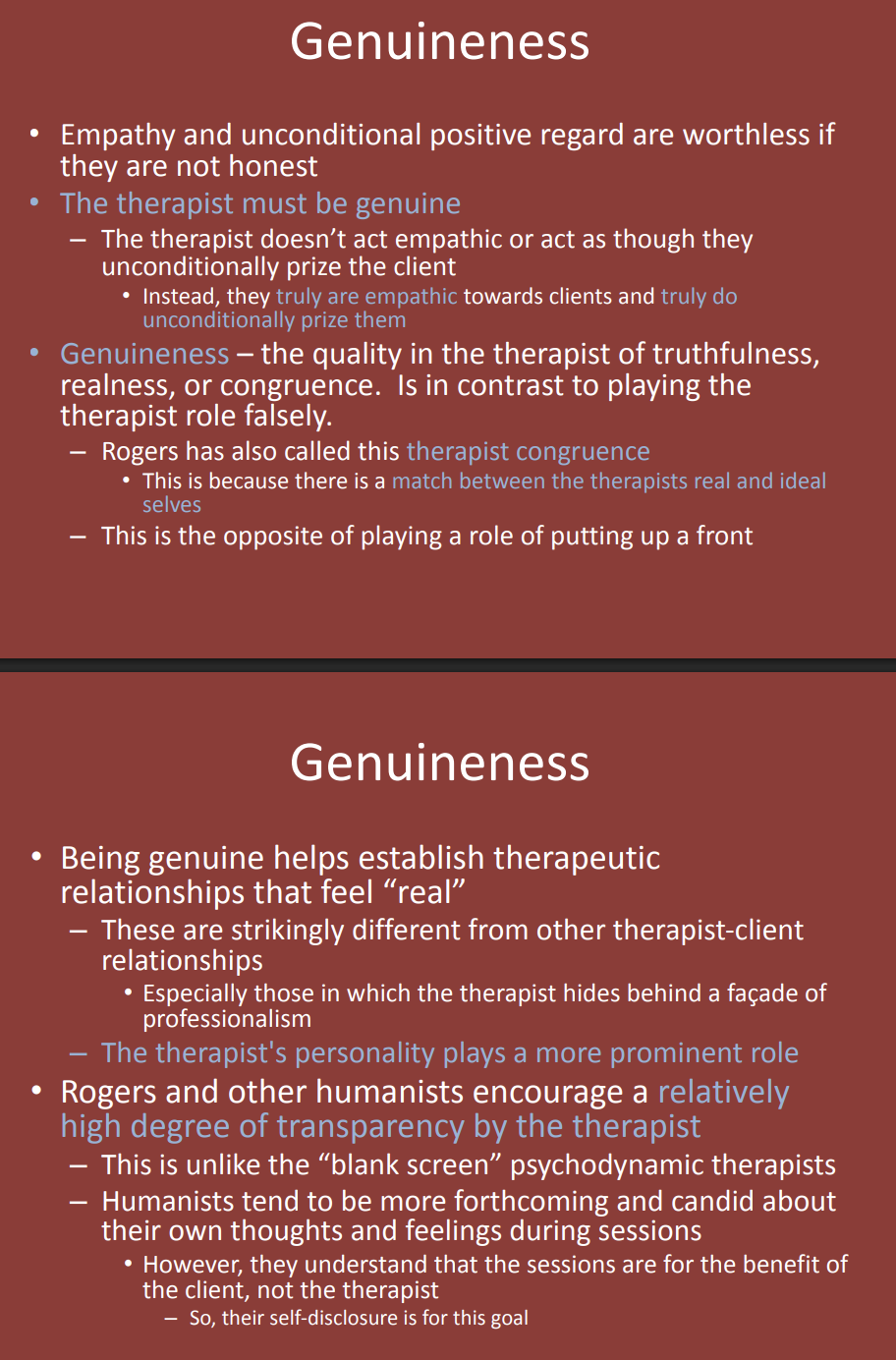
What do Rogers and other humanists encourage in therapy? (Genuineness)
They encourage therapist transparency, being more forthcoming and candid about their own thoughts and feelings while ensuring sessions remain client-centered.
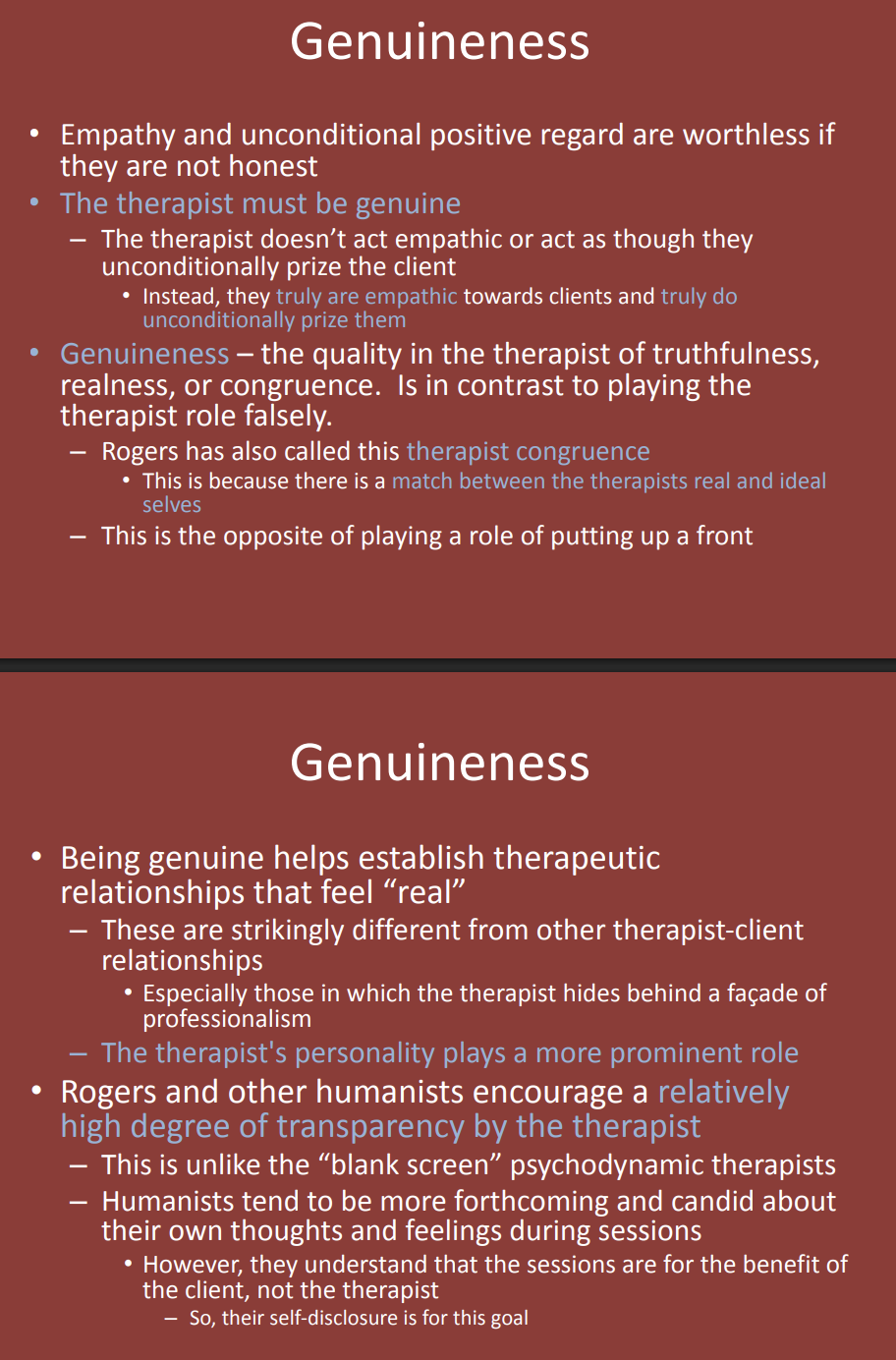
According to Rogers, if a therapist can create a relationship characterized by what three things? (Three Conditions)
Genuineness and transparency (being real),
Warm acceptance and prizing of the client as a separate individual,
A sensitive ability to see the client's world as they see it.
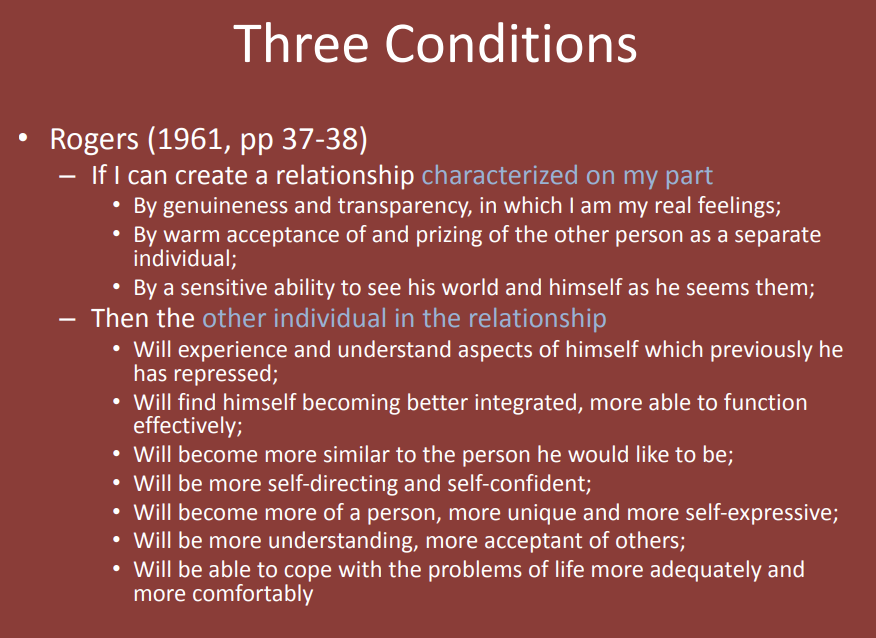
According to Rogers, what will happen to the client in such a relationship? (Three Conditions)
They will experience and understand previously repressed aspects of themselves.
Become better integrated and more effective in functioning.
Move closer to their ideal self.
Become more self-directing and self-confident.
Become more unique, expressive, and accepting of others.
Be better able to cope with life’s problems.
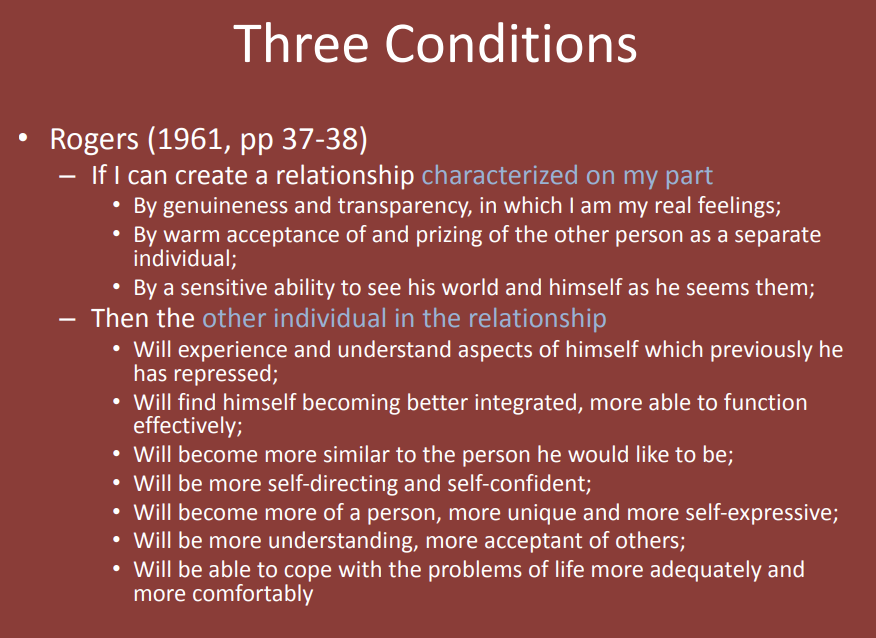
(Necessary and Sufficient?)
(Necessary and Sufficient?)
(Necessary and Sufficient?)
(Therapists Attitudes, Not Behaviors)
(Therapists Attitudes, Not Behaviors)
(Therapists Attitudes, Not Behaviors)
(Reflection)
(Reflection)
(Reflection)
(Alternatives to Humanism)
(Alternatives to Humanism)
(Alternatives to Humanism)
(Existential Psychotherapy)
(Existential Psychotherapy)
(Existential Psychotherapy)
(Existential Psychotherapy)
(Existential Psychotherapy)
(Gestalt Therapy)
(Gestalt Therapy)
(Gestalt Therapy)
(Positive Interventions and Strength-Based Counseling)
(Positive Interventions and Strength-Based Counseling)
(Positive Interventions and Strength-Based Counseling)
(Positive Interventions and Strength-Based Counseling)
(Positive Interventions and Strength-Based Counseling)
(Positive Interventions and Strength-Based Counseling)
(Positive Interventions and Strength-Based Counseling)
(Positive Interventions and Strength-Based Counseling)
(Positive Interventions and Strength-Based Counseling)
(Emotionally Focused Therapy)
(Emotionally Focused Therapy)
(Emotionally Focused Therapy)
(Emotionally Focused Therapy)
(Emotionally Focused Therapy)
(Emotionally Focused Therapy)